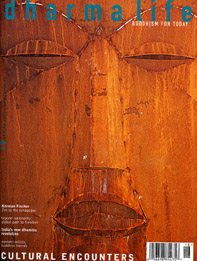Portraits of Buddhist Women
Ranjini Obeyesekere
SUNY Press, 2001
£12.75/ $17.95p/b
One of the best known and most accessible collections of the Buddha's sayings, the Dhammapada , moved from oral to written existence sometime in the first century bce. Over the next 1,000 years various translations of a commentary emerged, culminating in the 13th century Sinhala text Jewel Garland of the True Doctrine. The Jewel is a kind of post-canonical, folksy Dhammapada, a collection of moral tales that illustrate its doctrine for a lay audience. Portraits of Buddhist Women contains all the chapters from the Jewel that feature a woman as a central character - of which there are many. The translator chose these stories because she was interested in investigating shifts in the position of women and in issues of sexuality and gender during the 800 years spanned by various translations of the text.
The stories are variously entertaining, rambling, weird, violent. For instance, a queen who is a Stream Entrant and her retinue are locked into the palace. When a fire starts to consume the building, the trapped occupants reach very high levels of attainment. And, it turns out, the reason they burnt to death in this life is because in their past lives they had accidentally set fire to an Arahant (an Enlightened being) who was sitting under a pile of hay... Just as a story, it far surpasses, for example, Harry Potter.
In another tale a woman bends over in her bath and is molested by a dog. She does not stop the dog, and 'endures the pleasure'. She lies about the experience to her guileless husband, then devotes the rest of her life to supporting monks. When she dies, she goes to hell for seven days, and then to heaven. This is meant to illuminate the hazards of lying, and how one can balance bad karmic results ('demerit') with good ('merit'). It is interesting to note that her visit to hell resulted from lying - not from enjoying a carnal tryst with a dog.
These narratives take place within a literal and unquestioned belief system that includes rebirth, along with the hells and the heavens and their gods and goddesses. The character of the Buddha often explains away a death with a facile memory from a past life. Although I personally do not question the possibility of rebirth, this karmic reductivism created a fairy-tale quality that I thoroughly enjoyed. Arahants, I learnt, in addition to their transcendent wisdom and kindness, can also fly. Thus is science fiction with solid gold ethics.
The translator of Portraits of Buddhist Women was careful to note differences between the fifth and 13th-century versions of the text. The later version was 'localised' by the Sinhalese author-translator Dharma-sena who, among other things, added various agrarian metaphors with which villagers would have been (and still would be) familiar. One of my favourites is: 'Just as bats live in the houses of others but do no harm to it, so do not seek to harm those with whom one associates.'
The translator notes other changes, too, that highlight differences between Sinhalese and Indian cultural attitudes and behaviours - always, it seems, to the credit of the Sinhalese. Among other things, the newer text contains references to caste issues, which are absent from the earlier version.
The translator, understandably, wants to present documentation of a view of Sinhalese Buddhism that exemplifies spiritual inclusiveness in its view of women. The book does achieve this on many levels, but with a few exceptions. For example, one tale explains that a man who commits adultery will, after going to hell, be reborn as a woman 100 times. As positive and affirming as many of these tales are, we have not entirely got away from an unashamedly androcentric point of view.
The female voice in Buddhist literature is rare. Where we do meet women, they are often somewhat deprived of their humanity by the projections of men who do not understand them and who perhaps do not wish to. As this translator points out, we do owe the continued existence of these works to author-translators who, however flawed, have over many centuries given us access to works that might otherwise have been lost. So we can be grateful to the translator of Portraits of Buddhism Women, who has not only made more Dharma available to English-speakers but, perhaps more importantly, has brought to light some Buddhist parables that portray women as they should be portrayed - as human, spiritual beings.
Suvarnaprabha



